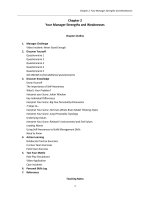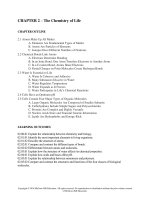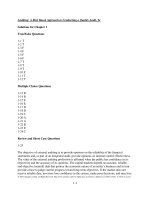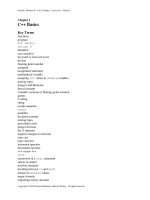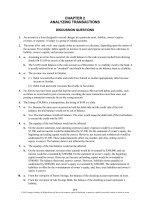Test bank and solution of psychological and spiritual well being (2)
Bạn đang xem bản rút gọn của tài liệu. Xem và tải ngay bản đầy đủ của tài liệu tại đây (385.01 KB, 24 trang )
2
Psychological and Spiritual Well-Being
Learning Objectives
After studying this chapter in the text, the student should be able to:
1. Identify the characteristics of emotionally healthy persons.
2. List and give examples of the three major areas of positive psychology.
3. Discuss the health benefits of spirituality.
4. Identify ways to enrich one’s spiritual life.
5. Describe four ways that sleep affects daytime well-being.
6. Identify risk factors in college students for mental health problems.
7. List the symptoms of major depression and discuss the pros and cons of using
antidepressants.
8. Discuss some of the factors that may lead to suicide, as well as strategies for
prevention.
9. List the criteria for considering therapy for a mental health program.
Chapter Summary
Psychological health can make the difference between facing a challenge with optimism
and confidence or feeling overwhelmed by expectations and responsibilities.
Lecture Outline
I.
Emotional and Mental Health
1. Psychological health encompasses both our emotional and our mental
states—that is, our feelings and our thoughts.
2. Emotional wellness generally refers to feelings and moods.
Chapter 2 – Psychological and Spiritual Well-Being 17
3. Characteristics of emotionally healthy persons, identified in an analysis of
major studies of emotional wellness, include the following:
a. Determination and effort to be healthy.
b. Flexibility and adaptability to a variety of circumstances.
c. Development of a sense of meaning and affirmation of life.
d. An understanding that the self is not the center of the universe.
e. Compassion for others.
f. The ability to be unselfish in serving or relating to others.
g. Increased depth and satisfaction in intimate relationships.
h. A sense of control over the mind and body that enables the person to
make health-enhancing choices and decisions.
4. Mental health describes our ability to perceive reality as it is, to respond to
its challenges, and to develop rational strategies for living.
5. The characteristics of mental health include:
a. The ability to function and carry out responsibilities.
b. The ability to form relationships.
c. Realistic perceptions of the motivations of others.
d. Rational, logical thought processes.
e. The ability to adapt to change and to cope with adversity.
6. Culture helps to define psychological health. In our diverse society, many
cultural influences affect Americans’ sense of who they are, where they
came from, and what they believe.
II.
Inside the Teen and Twenty-Something Brain
1. Brains of teens and young adults function differently than those of older
individuals. The under age 25 brain may not always grasp the long-term
consequences of an individual’s actions, set realistic priorities, or restrain
potentially harmful impulses.
III.
Learning from Positive Psychology
Positive psychology is defined as “the scientific study of ordinary human
strengths and virtues.”
The three major areas of positive psychology are the study of positive emotions,
such as hope and trust; positive traits, such as wisdom and courage; and positive
institutions, such as strong families and democracy.
A. Develop Self-Compassion: a healthy form of self-acceptance and a way of
conceptualizing our favorable and unfavorable attitudes about ourselves and
others. Three components of self-compassion are:
1. Treating oneself kindly in the face of perceived inadequacy by engaging in
self-soothing and positive self-talk.
Chapter 2 – Psychological and Spiritual Well-Being 18
B.
C.
D.
E.
F.
2. Recognizing that such discomfort is an unavoidable part of the human
experience. This recognition of “common humanity” promotes a sense of
connection to others even in the face of isolation and disappointment.
3. Facing painful thoughts without avoiding or exaggerating them and
managing disappointment and frustration by quelling self-pity and
melodrama.
Boosting Emotional Intelligence: “EQ” (for emotional quotient) is the ability
to monitor and use emotions to guide thinking and actions.
Know Yourself: two personality traits—conscientiousness and extroversion—
correlate with very different health behaviors.
1. Personality is not destiny. If you see yourself as low in conscientiousness
or high in extraversion you can take deliberate steps that will safe-guard
health.
Meet Your Needs. According to Maslow, human needs are the motivating
factors in personality development.
1. First, we must satisfy our basic physiological needs, such as those for
food, shelter, and sleep.
2. Only then can we pursue fulfillment of our higher needs—for safety and
security, love and affection, and self-esteem.
3. Few reach the state of self-actualization, in which one functions at the
highest possible level and derives the greatest possible satisfaction from
life.
Boost Self-Esteem
1. Self-esteem is belief or pride in ourselves; it gives us confidence to dare to
attempt to achieve at school or work, and to reach out to others to form
friendships and close relationships.
2. Self-esteem is based on what you believe about yourself. It is not
something you are born with; it develops over time.
3. One of the most useful techniques for bolstering self-esteem and achieving
your goals is developing the habit of positive thinking and talking.
Pursue Happiness
1. Psychological research has identified three major factors that contribute to
a sense of well-being: your happiness set-point, life circumstances such as
income or marital status, and thoughts, behaviors, beliefs, and goal-based
activities.
2. The individuals most likely to benefit from a “happiness prescription” are
motivated to change, bring to bear effort and persistence, and engage in
activities that have been proven effective in increasing happiness.
3. Education, intelligence, gender, and race do not matter much for
happiness.
Chapter 2 – Psychological and Spiritual Well-Being 19
G.
H.
I.
J.
4. In surveys of college students, the happiest generally shared one
distinctive characteristic: a rich and fulfilling social life.
Become Optimistic which is “an inclination to anticipate the best possible
outcome.”
1. Optimists not only expect good outcomes, they take steps to increase this
likelihood.
Manage Your Moods
1. A mood is a more sustained emotional state that colors our view of the
world for hours or days.
2. The most effective way to banish a sad or bad mood is by changing what
caused it in the first place.
3. Exercise consistently ranks as the single most effective strategy for
banishing bad feelings.
Look on the Light Side
1. Humor, which enables us to express fears and negative feelings without
causing distress to ourselves or others, is one of the healthiest ways of
coping with life’s ups and downs.
Develop Autonomy
1. For autonomous individuals, their locus of control is internal (from within
themselves) rather than external.
IV. Spiritual Health
Spiritual health refers to a breath of life and involves our ability to identify our
purpose in life and to experience the fulfillment of achieving our full potential.
Spirituality is a belief in what some call a higher power, in someone or
something that transcends the boundaries of self.
Religiosity refers to various spiritual practices.
A. Spirituality and Physical Health
1. A growing body of scientific evidence indicates that faith and spirituality
can enhance health—and perhaps even extend life.
2. Church attendance may account for an additional two to three years of
life.
3. Prayer and other religious experiences, including meditation, may
actually change the brain for the better.
B. Deepen Your Spiritual Intelligence
1. Spiritual intelligence is the capacity to sense, understand, and tap into the
highest parts of ourselves, others, and the world around us.
2. Spiritual intelligence, unlike spirituality, does not center on the worship of
an external God, but the discovery of wisdom within.
C. Clarify Your Values
Chapter 2 – Psychological and Spiritual Well-Being 20
D.
E.
F.
G.
1. Values are the criteria by which you evaluate things, people, events, and
yourself; they represent what’s most important to you.
2. When you confront a situation in which you must choose different paths
or behaviors, follow these steps:
a. Carefully consider the consequences of each choice.
b. Choose freely from among all of the options.
c. Publicly affirm your values by sharing them with others.
d. Act out your values.
Enrich Your Spiritual Health
1. Sit quietly.
2. Step outside.
3. Use activity to tune into your spirit.
4. Ask questions of yourself.
5. Trust your spirit.
6. Develop a spiritual practice.
Consider the Power of Prayer
1. Prayer is the most commonly used form of complementary and alternative
medicine.
a. Petitionary prayer—praying directly to a higher power—affects both
the quality and quantity of life.
b. Some scientists speculate that prayer may foster a state of peace and
calm that could lead to beneficial changes in the cardiovascular and
immune systems.
Cultivate Gratitude
1. A grateful spirit brightens mood, boosts energy, and infuses daily living
with a sense of glad abundance.
2. Gratitude has emerged as one of the most significant dimensions of
positive psychology.
3. The traditional definition of gratitude of “appreciation for the helpful
actions of others, has expanded to include “a lifestyle orientation” of
feeling grateful, which can reduce levels of stress over time.
Forgive
1. When you forgive, you let go of all the anger and pain that have been
demanding your time and wasting your energy.
2. When you forgive, you reclaim your power to choose.
3. Forgiveness based interventions have resulted in greater self-esteem and
hopefulness, positive emotions toward others, less depression and
anxiety, and improved resistance to drug use.
Chapter 2 – Psychological and Spiritual Well-Being 21
V. Sleepless on Campus
According to the Centers for Disease Control and Prevention, only 1/3 of
Americans say they get enough sleep. Inadequate sleep and sleep disorders are
linked to higher overall death rates, as well as to higher rates of motor vehicle
crashes, obesity, insulin resistance, and cardiovascular illness.
A. Sleepy Students
1. In various studies, 25 to 50 percent of undergraduates have reported
significant daytime sleepiness, which may affect academic performance as
well as daily tasks such as driving.
2. Alcohol compounds many sleep problems.
3. Female students generally have poorer sleep patterns than males and
suffer more consequences as a result.
4. On average college students go to bed 1 to 2 hours later and sleep 1 to 1.6
hours less than students of a generation ago.
B. Sleep’s Impact on Health
1. Nighttime sleep affects your daytime well-being in the following areas:
a. Learning and memory
b. Metabolism and weight
c. Safety
d. Mood/quality of life
e. Life satisfaction
f. Cardiovascular health
g. Immunity/cancer prevention
C. How Much Sleep Do You Need?
1. Normal sleep times range from five to ten hours; the average is seven and
a half.
2. To figure out your sleep needs, keep your wake-up time the same every
morning and vary your bedtime. See how you feel throughout the day.
D. Sleeping Pills
1. Before taking sleeping pills, the following should be considered:
a. Over-the-counter medications
b. Dietary supplements
c. Prescription medications
VI. Understanding Mental Health
A. What Is a Mental Disorder?
1. Psychiatrists define a mental disorder as a clinically significant behavioral
or psychological syndrome or pattern that is associated with present
distress or disability or with a significantly increased risk of suffering
death, pain or disability, or an important loss of freedom.
Chapter 2 – Psychological and Spiritual Well-Being 22
2. Various personality types and behaviors have also been linked to certain
illnesses.
VII. Mental Health on Campus
In the American College Health Association National College Assessment,
almost half of the undergraduates surveyed reported feelings that things were
hopeless within the last 12 months.
According to the American College Counseling Association, more students are
seeking counseling, with more serious problems than in the past.
A. Students at Risk
1. Among the strongest factors that put college students at risk for mental
problems is a romantic breakup or loss.
B. The Toll on Students
1. Psychological and emotional problems can affect every aspect of a
student’s life, including physical health, overall satisfaction, and
relationships.
2. The impact of mental health problems extends beyond an individual
student to roommates, friends, classmates, family, and instructors.
3. Many schools are setting up programs to identify students at risk and
refer them for follow-up and professional treatment.
VIII.
Depressive Disorders
Depression, the world’s most common mental ailment, affects more than 13
million adults in the United States every year and costs billions of dollars for
treatment and lost productivity and lives.
A. Depression in Students
1. An estimated 15 to 40 percent of college-age men and women may
develop depression, but the number may be rising.
2. Three key contributors to depression in college students are stress,
substance abuse, and sleep loss.
B. Gender and Depression
1. Female Depression
a. Depression is twice as common in women as men.
b. Brain chemistry and sex hormones may play a role.
c. Childhood abuse also contributes to female vulnerability.
2. Male Depression
a. Experts describe male depression as an “under” disease: underdiscussed, under-recognized, under-diagnosed, and undertreated.
b. Genes may make some men more vulnerable to depression, but
chronic stress of any sort plays a major role.
Chapter 2 – Psychological and Spiritual Well-Being 23
C. Dysthymic Disorder:
1. Is a depressive disorder characterized by a chronically depressed mood.
2. Symptoms include feelings of inadequacy, hopelessness, and guilt; low
self-esteem; low energy; fatigue; indecisiveness; and an inability to enjoy
pleasurable activities.
D. Minor Depression:
1. Is a common disorder that is often unrecognized and untreated, affecting
about 7.5 of Americans during their lifetime.
2. Its symptoms are the same as those of major depression, but less severe
and fewer in number.
3. Psychotherapy, medication, and exercise are remarkably effective for mild
depression.
E. Major Depression
1. The simplest definition of major depression is sadness that does not end.
2. The characteristics of depression include:
a. Feeling depressed.
b. Loss of interest.
c. Eating more or less.
d. Having trouble sleeping.
e. Feeling slowed down.
f. Lack of energy.
g. Feeling helpless, hopeless, and worthless.
h. Difficulty concentrating; forgetfulness.
i. Difficulty thinking clearly or making decisions.
j. Persistent thoughts of death or suicide.
k. Withdrawal from others.
l. Physical symptoms.
F. Treating Depression
1. The most recent guidelines for treating depression call for an
individualized approach tailored to each patient’s symptoms.
2. Medication has become the most common approach, while fewer patients
receive psychotherapy, possibly because of limited insurance coverage.
3. For individuals who cannot take antidepressant medications because of
medical problems, or who do not improve with psychotherapy or drugs,
electroconvulsive therapy (ECT) remains the safest and most effective
treatment.
G. Bipolar Disorder
1. Known as manic depression in the past, bipolar disorder consists of mood
swings, changes in thinking, changes in behavior, and changes in physical
condition.
Chapter 2 – Psychological and Spiritual Well-Being 24
2. Professional therapy is essential in treating bipolar disorders.
IX. Anxiety Disorders
Anxiety disorders are as common as depression and are often undetected and
untreated.
A. Phobias
1. Phobias—the most prevalent type of anxiety disorder—are out-of-theordinary, irrational, intense, persistent fears of certain objects or
situations.
2. The best approach is behavioral therapy, which consists of gradual,
systematic exposure to the feared object.
B. Panic Attacks and Panic Disorder
1. Panic attacks often involve one or more of the following: a racing heart,
light-headedness or dizziness, rapid breathing, hyperventilation, tingling
and numbness in parts of the body, and the sense that something horrible
is about to happen.
2. Panic disorder develops when attacks recur or apprehension about them
becomes so intense that individuals cannot function normally.
C. Generalized Anxiety Disorder (GAD)
a. GAD involves excessive or unrealistic apprehension that causes
physical symptoms and lasts for six months or longer.
D. Obsessive–Compulsive Disorder (OCD)
a. Obsession: a recurring idea, thought, or image that they realize, at least
initially, is senseless.
b. Compulsion: a repetitive behavior performed according to certain
rules or in a stereotyped fashion.
X. Attention Disorders
A. Attention-deficit/hyperactivity disorder (ADHD) is the most common mental
disorder in childhood.
1. An estimated 9 percent of school-age children suffer from ADHD.
2. About 4 percent of college students have ADHD.
3. Hyperactivity in adults with ADHD is more subtle, an internal fidgety
feeling rather than a physical restlessness.
4. ADHD can make it hard to concentrate, read, make decisions, complete
complex projects, meet deadlines, and can make relationships with peers
challenging.
5. The medications used for this disorder include stimulants (Ritalin) or an
alternative nonstimulant treatment known as Strettera (atomoxetine).
Chapter 2 – Psychological and Spiritual Well-Being 25
6. Undergraduates with ADHD are at higher risk of becoming smokers,
abusing alcohol and drugs, and having automobile accidents.
XI. Autism Spectrum Disorders
1. Autism is a complex neurodevelopmental disability that causes social and
communication impairments, is a “spectrum” disorder that includes
several disorders with similar features.
2. It is unclear as to why Autism rates have risen steadily in recent decades.
3. Symptoms, which include repetitive patterns of thoughts and behavior
and inability to communicate verbally, usually start before age three and
can create delays or problems in many different skills that develop from
infancy to adult-hood.
4. Individuals with Asperger syndrome have autism-like problems in social
interaction and communication but normal to above-average intelligence.
XII. Schizophrenia
A. Schizophrenia is one of the most debilitating mental disorders, which
profoundly impairs in individual’s sense of reality.
B. Symptoms:
1. Hallucinations
2. Delusions
3. Inability to think in a logical manner
4. Talking or rambling in incoherent ways
5. Making odd or purposeless movements or not moving at all
6. Repeating others’ words or mimicking their gestures
7. Showing few if any feelings
8. Lacking will or motivation to complete a task or accomplish something
9. Functioning at a much lower level than in the past
C. Antipsychotic drugs are the foundation of treatment.
XIII. Suicide
Suicide is not in itself a psychiatric disorder, but it is often the tragic consequence
of emotional and psychological problems.
At all ages, men commit suicide three to four times more frequently than women,
but women attempt suicide much more often than men.
A. Suicide on Campus
1. More than 1,100 undergraduates take their lives every year.
B. Factors That Lead to Suicide
1. Mental disorders
2. Substance abuse
Chapter 2 – Psychological and Spiritual Well-Being 26
3.
4.
5.
6.
7.
8.
9.
Hopelessness
Combat stress
Family history
Physical illness
Brain chemistry
Access to guns
Other factors
a. Individuals who kill themselves often have gone through more major
life crises—job changes, births, financial reversals, divorce,
retirement—in the previous six months, compared with others.
XIV. Overcoming Problems of the Mind
At any given time, about 25 percent of men, women, and children meet the
criteria for a mental disorder, yet 70 percent of those in need of psychological
help never receive it.
A. Where To Turn for Help
1. Health education instructor or department, school-based support groups,
community-based programs, special emergency services, student health
services, office of the dean of student services or student affairs, city or
county health department and neighborhood health centers, special clinics
in local hospitals, local branches of national service organizations,
psychiatric or psychological association, primary care physician,
telephone book, or the Internet.
B. Types of Therapy
1. Psychotherapy refers to any type of counseling based on the exchange of
words in the context of the unique relationship that develops between a
mental health professional and a person seeking help.
2. Psychodynamic Psychotherapy
a. This therapy takes into account the role of early experiences and
unconscious influences in actively shaping behavior.
3. Cognitive-Behavioral Therapy (CBT)
a. CBT focuses on inappropriate and inaccurate thoughts or beliefs to
help individuals break out of a distorted way of thinking.
b. Behavioral therapy strives to substitute healthier ways of behaving for
maladaptive patterns used in the past.
4. Interpersonal Therapy (IPT)
a. IPT focuses on relationships in order to help individuals deal with
unrecognized feelings and needs and improve their communication
skills.
C. Other Treatment Options
Chapter 2 – Psychological and Spiritual Well-Being 27
1. Psychiatric Drugs
a. Psychiatric drugs are medications that alter brain chemistry and
relieve psychiatric symptoms.
2. Alternative Mind-Mood Products
3. Yoga, meditation, herbs, vitamins, and massage and acupressure.
Discussion Questions
Discuss the concept of psychological health as it relates to the other five dimensions
of health. Can psychological health be separate and distinct from the other
components without affecting them? How so? How do the other dimensions affect
one’s psychological health?
Ask students what it means to love and accept themselves. Can one accept and love
another without first loving oneself? How? Why? How does this relate to Maslow’s
hierarchy of thinking?
Ask students what emotional intelligence means to them. Discuss the benefits of
possessing emotional intelligence. What role does an individual’s EQ play in their
everyday life or career? Ask them which they would rather have, a high IQ or a high
EQ? Why or why not?
Ask students what factors contribute to happiness. Compare these characteristics to
those cited for contributing to good psychological health. Ask students to make a list
of the things that make them happy. Do they think of the things on the list when
they make choices or decisions that may or may not affect their happiness? Why?
How come?
Discuss the concept of sleep deprivation as discussed in the text. Ask for volunteers
who have experienced it to share their symptoms or experiences. Ask others to share
the strategies and rituals they use in order to reduce sleep deprivation and maximize
restful sleep. How might they improve their sleep rituals? Why is it important at this
point in their lives to get enough sleep?
Provide a definition for mental well-being and for mental illness. Have students
brainstorm characteristics and symptoms for each. Also work through the
stereotypes of mental illness and attempt to explain how “normal” people can
become so overwhelmed by “life” that depression or other illnesses occur.
Compare and contrast the everyday blues to depressive disorder. What
characteristics differentiate the two? When might one seek professional counseling?
Chapter 2 – Psychological and Spiritual Well-Being 28
How and where can they get it? What is available on campus? How might one
afford such counseling? Describe the free services available and who to contact.
After reviewing the statistics related to suicide among the young, ask students why
they believe this occurs. Note their responses on the chalkboard. Ask them to
examine what society, families, and individuals can do to help prevent suicide.
Ask students how they might go about finding a mental health therapist. What
questions might they ask in order to ascertain qualifications and experiences? (Have
them note that a similar list can be used to select any type of health practitioner).
Formulate and share with them a list of low or no-cost counseling services available
on your campus and within the community. Discuss the differences in psychiatrists,
psychologists, and social workers. Also explain how some psychologists are trained
in special areas.
Discuss the number of psychiatric drugs that are out there and the differences
between them. How do students view these types of drugs? How many students
support Tom Cruise’s belief that they are not needed to treat depression? Why or
why not?
Discuss suicide, including the major causes of suicide. Discuss the differences
between males and females in terms of suicide risk.
Chapter 2 – Psychological and Spiritual Well-Being 29
Classroom Activities
Activity #1: Abraham Maslow’s Hierarchy of Needs
Purpose:
To assist students in identifying their own potential.
Time:
This activity will take 10 to 15 minutes.
Introduction:
Introduce to students how not reaching our fullest potential can impact our health.
Method:
1.
Introduce to students Maslow’s Hierarchy of Needs and review the various levels
within this model.
2.
Have students make their own pyramid and have them write a brief statement
about how they have reached each level or not reached a particular level.
Discussion:
1.
Ask students to identify areas that they are meeting.
2.
Ask students to identify areas that they are not meeting.
3.
How do they feel meeting or not meeting a particular area that has influenced their
life?
4.
Are there areas in life for which students believe that meeting each “step” isn’t
necessary to achieve the next level? Why or why not?
5.
Ask students to identify someone they believe has reached the self-actualization
level. Why?
Chapter 2 – Psychological and Spiritual Well-Being 30
Activity #2: Enhancing Self-Esteem
Purpose:
To improve self-esteem.
Time:
This activity will take 10 to 15 minutes.
Introduction:
Enhancing self-esteem and personal well-being is a lifelong process.
Method:
1.
Have students ask themselves the following questions:
a. How do I feel about my life in general—positively or negatively?
b. Do I constantly send myself negative messages?
c. What is one area of my life that I would like to improve upon?
2.
Write two positive affirmations that you will repeat to yourself whenever you feel
those negative or self-defeating thoughts begin to enter your mind.
Discussion:
1.
What factors have contributed to your feelings about your life in general, whether
they are positive or negative?
2.
Will your positive affirmations help derail any negative observations you have of
yourself?
3.
What role does self-esteem play in the ability to set and establish goals?
Chapter 2 – Psychological and Spiritual Well-Being 31
Activity #3: Self-Analysis: Depression
Purpose:
To increase awareness of signs of depression.
Time:
This activity will take one-half to a whole class period with possible out of class
research.
Introduction:
Improving the ability to recognize the signs and symptoms of depression and to
develop healthy strategies for coping with depression.
Method:
1.
Have students ask themselves the following questions:
a. Do I have low self-esteem or feelings of inadequacy?
b. Do I feel hopeless?
c. Do I feel guilty?
d. Do I have low energy and have feelings of fatigue?
e. Am I having difficulty making decisions?
f. Am I having difficulty enjoying pleasurable activities?
2.
If students answered yes to any of those questions, then they should recognize that
they could be suffering from depression.
Discussion:
1.
Ask students to reflect on how they feel about this experience? Were they surprised
by the results?
2.
Does this experience open their eyes to taking more time to work on their mental
health and well-being?
3.
If they are dealing with depression, what resources will they seek for help?
4.
What resources are available on campus for students dealing with depression?
Chapter 2 – Psychological and Spiritual Well-Being 32
Activity #4: Self-Analysis: Sleep
Purpose:
To assess your daily sleep habits and to determine if you are getting an adequate
amount of rest for optimal health.
Time:
One week.
Method:
1.
Students should keep a sleep journal for one week. Students should keep track of
the amount of time they sleep each day, the time at which they are sleeping, and
how they felt upon waking each day.
2.
At the end of one week, students should ask themselves the following questions:
a. Do I wake up each day feeling well rested?
b. Do I go to sleep at a different time each day?
c. Am I taking a nap every day?
d. Do I have to take medications or drink alcohol to go to sleep?
Discussion:
1.
Discuss the behavioral patterns that impact the amount of sleep students get on a
daily basis.
2.
Ask students if they have a clearer picture of their sleep habits and how they might
be influencing their physical health.
3.
Discuss the steps that students can take to improve their sleep habits.
Chapter 2 – Psychological and Spiritual Well-Being 33
References, Readings, and Resources
American College Health Association. American College Health Association–National
College Health Association: Reference Group Executive Summary, Fall 2007. Baltimore:
American College Health Association, 2008.
Buysee, D. “Sleep Disorders,” in Textbook of Psychiatry, Fifth Edition, 2008, pp. 921–970.
Dubovsky, S. “Emotional Health = Heart Health,” Journal Watch Psychiatry, Jan. 2008.
Hollander, Eric and Daphne Simeon. “Anxiety Disorders,” in Textbook of Psychiatry, Fifth
Edition. Hales, Robert, Yudofsky, Stuart, and Gabbard Glen, Editors. Washington, DC, 2008, pp.
505–608.
Joffe P. “An Empirically Supported Program to Prevent Suicide in a College Student
Population,” Suicide Life Threatening Behavior, 2008, Feb; 38(1): pp. 87–103.
Joska, John and Dan Stein. “Mood Disorders,” in Textbook of Psychiatry, Fifth Edition. Hales,
Robert, Yudofsky, Stuart, and Gabbard Glen, Editors. Washington, DC, 2008, pp. 457–504.
Kaplan, Arline. “Task Force Proposes New Bipolar Guidelines,” Psychiatric Times, Apr. 2008,
Vol. XXV, No. 4, p. 1.
Larsen, J. “Is Happiness Having What You Want, Wanting What You Have, or Both?”
Psychological Science, 19(4), Apr. 2008, pp. 371–377.
Schlundt, D. G. “Religious Affiliation, Health Behaviors and Outcomes: Nashville REACH
2010,” British Journal of Nursing, 17(6), 2008, pp. 394–398.
Weiss, A. “Happiness Is a Personal(ity) Thing: The Genetics of Personality and Well-Being in a
Representative Sample,” Psychology Science, 19(3), Mar. 2008, pp. 205–210.
Wright, Jesse et al. “Cognitive Therapy,” in Textbook of Psychiatry, Fifth Edition. Hales, Robert,
Yudofsky, Stuart, and Gabbard Glen, Editors. Washington, DC, 2008, pp. 1211–1256.
Chapter 2 – Psychological and Spiritual Well-Being 34
Films and Videos
Anger: The Turbulent Emotion
(Can pent-up anger lead to health problems? A look at anger and its causes.)
Human Relations Media
175 Tompkins Avenue
Pleasantville, NY 10570
A Beautiful Mind
(The story of John Nash, Nobel Prize Winner who suffered from schizophrenia.)
Available at most video stores.
A Family of Winners
(Overemphasis on winning and obsessive competitiveness is examined in the context of
a father’s “winning-is-everything” personality and its effect on his sons.)
Paul Communications
17575 Pacific Coast Highway
P.O. Box 1057
Pacific Palisades, CA 90272
Beating Depression
(This program comes to grips with depression through the experiences of five patients
whose backgrounds span the socioeconomic spectrum.)
Films for the Humanities and Sciences
P.O. Box 2053
Princeton, New Jersey 08543-2053
1-800-257-5126
Cipher in the Snow
(Mental health authorities discuss anxiety and anxiety-producing situations.)
The Edge Series
Pennsylvania State University
Audio-Visual Services
University Park, PA 16802
Chapter 2 – Psychological and Spiritual Well-Being 35
Clarifying Your Values: Guidelines for Living
(Students are given opportunities to define their value systems and analyze advantages
and disadvantages of acting on their beliefs.)
The Center for Humanities, Inc.
White Plains, NY 10602
Depression: Moving On
(Comprehensive film spells out the details of clinical depression in seven concise
segments.)
Films for Humanities and Sciences
P.O. Box 2053
Princeton, NJ 08543-2053
The Emotions of Life
(An examination of aggression, depression, and addiction.)
Mastervision Incorporated
969 Park Avenue
New York, NY 10028
Girl Interrupted
(Excellent movie about a young woman who is in a mental institution and the
friendship and relationships endured.)
Check your local video store.
Look at Schizophrenia
(A psychiatrist presents ways that schizophrenics use feelings and language.)
Hogg Foundation Library
P.O. Box 7998
University of Texas
Austin, Texas 78712
Mental Health
(The importance of expressing emotions, being the person you are, and accepting
yourself.)
Michigan Media
University of Michigan
400 Fourth Street
Ann Arbor, MI 48109
Chapter 2 – Psychological and Spiritual Well-Being 36
Myths about Madness: Challenging Stigma and Changing Attitudes
(Exposes myths surrounding afflictions of the mind and challenges discrimination
against the mentally ill.)
Films for Humanities and Sciences
P.O. Box 2053
Princeton, NJ 08543-2053
New Strides in Mental Health
(Attitudes toward mental health are discussed by the former president of the National
Mental Health Association.)
Hogg Foundation Library
P.O. Box 7998
University of Texas
Austin, TX 78712
Productivity and the Self-Fulfilling Prophecy
(Shows the strength of expectations and how they influence our behavior.)
McGraw-Hill Training Systems
674 Via del la Valle
Solana Beach, CA 92075
Suicide: A Guide for Prevention
(Uses dramatized scenarios for who is at risk, warning signs, and some of the triggers.)
Films for Humanities and Sciences
P.O. Box 2053
Princeton, NJ 08543-2053
Suicide: The Warning Signs
(Discussion of the common warning signs of suicide and how others can deal with
them.)
Centron Films
65 East South Water Street
Chicago, IL 60607
Chapter 2 – Psychological and Spiritual Well-Being 37
What Is Mental Health?
(A well-known psychologist discusses mental health and “normal” behavior, and how
they are measured.)
Hogg Foundation Library
P.O. Box 7998
University of Texas
Austin, TX 78712
Internet Resources
American Association of Suicidology
The American Association of Suicidology is an education and resource organization.
/>Anxiety Disorders Association of American (ADAA)
Gives information, resources, and referrals related to anxiety disorders.
American Foundation for Suicide Prevention
Research, facts, survivor support, and more.
/>American Psychiatric Association
Provides information about a wide variety of mental health problems as well as
psychiatric medications.
American Psychological Association
Provides information on a wide variety of mental health topics.
Depression and Bipolar Support Alliance
The mission of this website is to improve the lives of people living with mood
disorders.
/>
Chapter 2 – Psychological and Spiritual Well-Being 38
Depression Screening.org
The mission of this website is to educate people about clinical depression, offer a
confidential way for people to get screened for symptoms of the illness, and guide
people toward appropriate professional help if necessary.
/>National Association for Self-Esteem
The purpose of this organization is to fully integrate self-esteem into the fabric of
American society so that every individual, no matter what their age or background,
experiences personal worth and happiness.
/>
National Center for PTSD
To advance the clinical care and social welfare of America’s veterans through research,
education, and training in the science, diagnosis, and treatment of PTSD and stressrelated disorders. This website is provided as an educational resource concerning PTSD
and other enduring consequences of traumatic stress.
/>National Depressive and Manic-Depressive Association (NDMDA)
Provides information and materials for manic depression and depression.
National Institute of Mental Health
Working to improve mental health through biomedical research on mind, brain, and
behavior.
/>National Mental Health Association
This site features fact sheets on a variety of mental health topics, including depression
screening, information for families, college initiative, substance abuse, prevention, and
an email newsletter. This site also features current mental health articles as well as a
bookstore.
National Sleep Foundation
This site features information on sleep disorders; healthy sleep, support, and advocacy;
and online resources on sleep.
Chapter 2 – Psychological and Spiritual Well-Being 39
Obsessive Compulsive Foundation
Organization of researchers and clinicians pioneering the world’s foremost innovative
and aggressive efforts to find a cure for OCD.
/>Reflective Happiness
Martin Seligman’s website on positive psychology.
/>Suicide: Read this First
A collection of suicide resources.
/>The Mental Health Research Association
This association is dedicated to funding scientific research on brain and behavior
disorders.
/>World Federation for Mental Health
An international, non-profit organization established in 1948 to advance, among all
peoples and nations, the prevention of mental and emotional disorders, the proper
treatment and care of those with such disorders, and the promotion of mental health.
/>World Health Organization
Part of the WHO’s website on mental health.
/>
Chapter 2 – Psychological and Spiritual Well-Being 40

